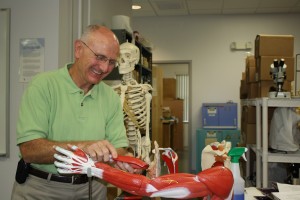
DUBOIS – Classrooms and laboratories are not what they used to be just a few short years ago. Rapidly changing technologies have changed the way classes are taught at schools and universities across the country, and around the globe. Robert Agnew, Instructor of Biology at Penn State DuBois, is particularly aware of these rapid changes, and has embraced the new high-tech tools he is able to use in the classroom. His work in integrating new technology, or even using technology to replace older, less desirable methods of teaching, has earned him some recognition.
Agnew has been invited to present his research on the benefits of technology in instructional biology laboratories at the College of Southern Maryland’s Fourth Annual Mid-Atlantic Regional Conference in October.
Agnew has, for the past two years, utilized software programs and 3-D models to teach anatomy, specifically that of human beings. It has been a welcomed alternative to the dissection of cats, which was once a necessary part of the courses. In generations past, the same lessons were also taught by using actual human cadavers.
“Cadavers are hard to come by and legally obtain in this day in age. It’s just beyond the scope of what most campuses can do,” Agnew said. “Plus, students aren’t comfortable with using cadavers. Students also didn’t like the cats.”
Agnew said the software he uses now simulates human anatomy so well, that there simply is no need for the real thing in the laboratory. Plus, it keeps students comfortable with their work. Also, since software can be used by many more people than traditional models, students in lower level classes are able to begin the advanced work much sooner.
“When I was in school, I was a senior before I ever had a course like this,” Agnew said. “Now freshmen are taking this.”
Agnew is currently working to compare the grades of present students using the software with grades of past students who were required to dissect cats in the labs. He suspects he’ll find significant improvement in grades thanks to more modern teaching tools.
“I no longer teach the way I was taught. I’ve seen instructional technology evolve from slide projectors and a collection of cassette tape players, to a seemingly limitless array of technologies,” Agnew said. “Students do benefit from this blended approach to teaching biology courses.”
Agnew’s research into these new methods has been funded by a grant from the Schreyer Institute for Teaching Excellence, and the DuBois Educational Foundation. He’ll present his work at the College of Southern Maryland on Oct. 22.
Steve Harmic, Penn State DuBois